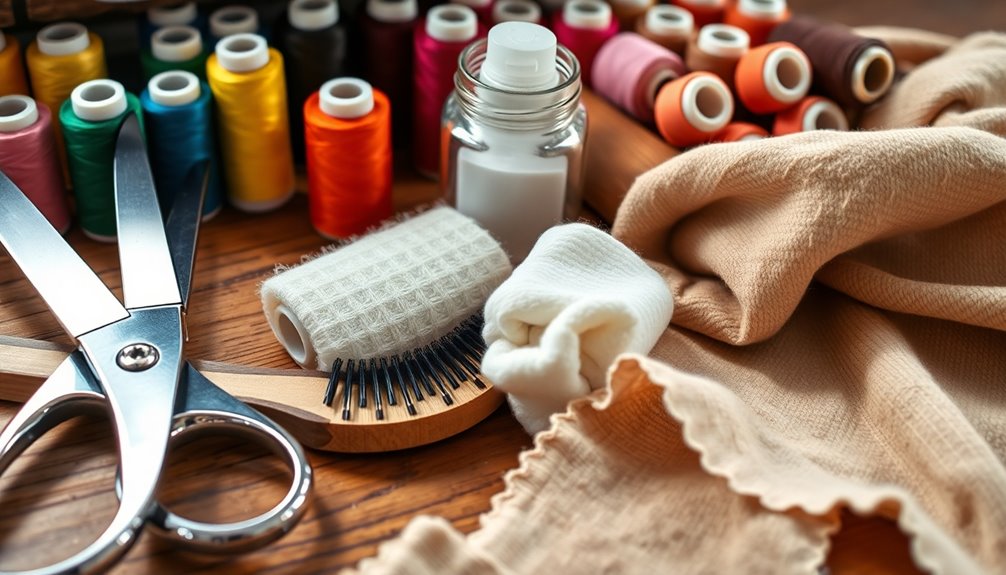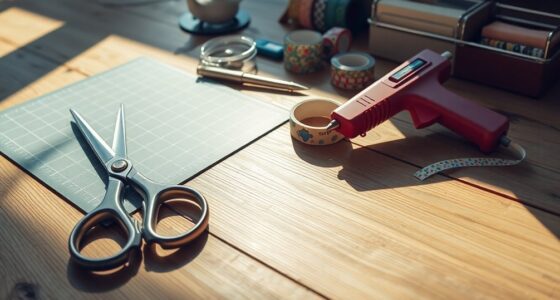Maintaining your crafting tools is essential for their longevity and performance. Regular cleaning prevents dust and debris buildup, while a maintenance schedule can save you from costly replacements. Store your tools in a cool, dry area and use quality containers to keep them dust-free. Don't forget to organize and label your supplies for easy access. With these basics in mind, you'll find your crafting experience improved and efficient. Let's explore more practical tips together.
Key Takeaways
- Establish a regular maintenance schedule to extend the lifespan of your crafting tools and avoid costly replacements.
- Clean tools after each use with appropriate techniques, like warm, soapy water for stamps and rubbing alcohol for non-porous surfaces.
- Organize supplies using clear storage solutions and a labeling system to maintain visibility and easy access.
- Follow best practices for sewing tools, including regular cleaning, needle changes, and proper storage to enhance performance.
- Conduct routine inspections for signs of wear and store tools in a dry, climate-controlled environment to prevent damage.
The Importance of Regular Maintenance for Crafting Tools
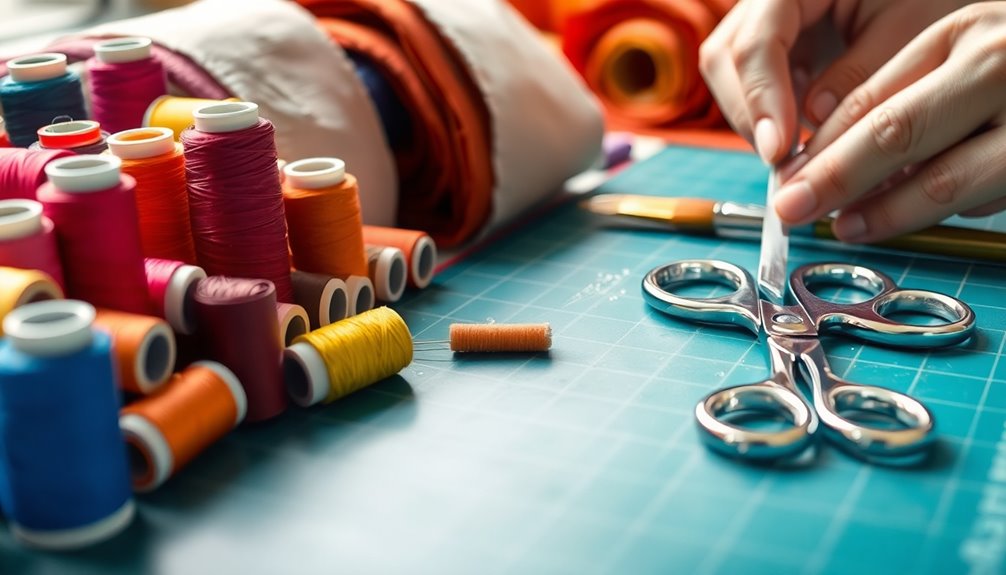
Regular maintenance of your crafting tools is essential for keeping them in top shape and extending their lifespan. By setting up a regular maintenance schedule, you can effectively prevent damage that leads to costly replacements.
Make it a habit to clean your tools after each use to avoid dust and debris buildup, which can hinder their peak performance. Don't forget to inspect your tools regularly for signs of wear; this proactive approach can save you from unexpected tool failures.
For sewing machines, consider a yearly professional service to maintain efficiency. Changing needles after each project enhances your crafting productivity.
Essential Cleaning Techniques for Craft Supplies
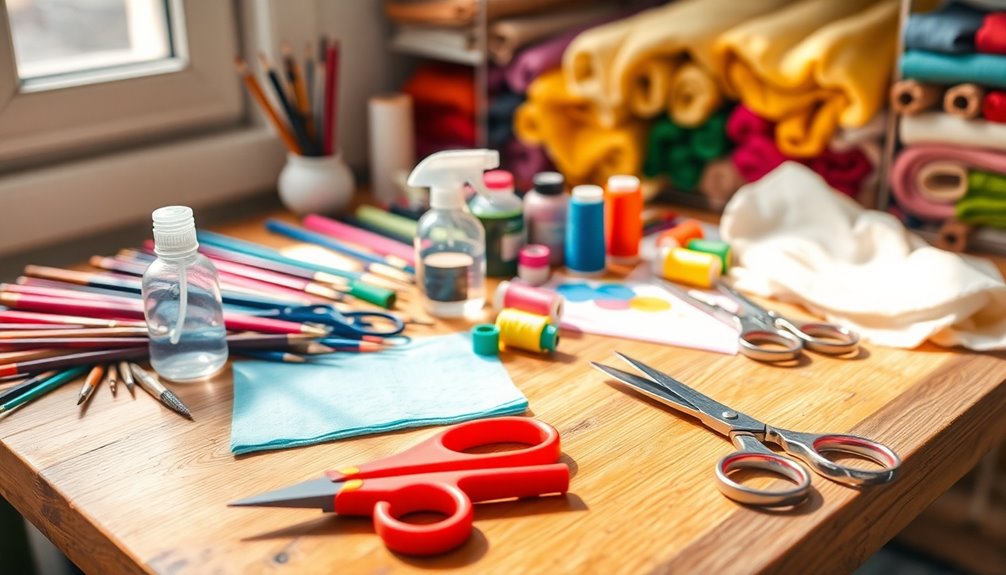
Maintaining your crafting tools goes beyond just checking for wear; it also involves keeping them clean. Regular cleaning helps guarantee peak performance and longevity. Here are three essential techniques:
- Clear Stamps: Clean with a specialized stamp cleaner or warm, soapy water to remove ink residue and maintain quality.
- Non-Porous Tools: Use rubbing alcohol to effectively remove dried glue and paint, keeping your tools in top condition.
- Ink Blending Brushes: Rinse under lukewarm water immediately after use, applying mild soap for stubborn ink to prolong their lifespan.
Establish a routine to clean and inspect your supplies. This simple care guarantees you maintain their usability and can store them properly, ready for your next crafting adventure.
Storage Solutions to Keep Your Craft Area Organized

How can you transform your crafting area into an organized haven? Start by implementing smart storage solutions that enhance visibility and access to your craft materials.
Clear plastic storage pouches are perfect for small items like embellishments and sequins, keeping them dust-free while allowing you to see what's inside. Invest in clear stackable storage boxes to efficiently organize random supplies.
Don't forget to utilize vertical space with wall-mounted pegboards or hanging shelves to maximize your crafting space. A labeling system for your storage containers will help you quickly identify specific materials, streamlining your process.
Finally, designate areas for different types of supplies—group adhesives, papers, and fabrics together to maintain an organized and efficient crafting area.
Best Practices for Care of Sewing Tools and Machines
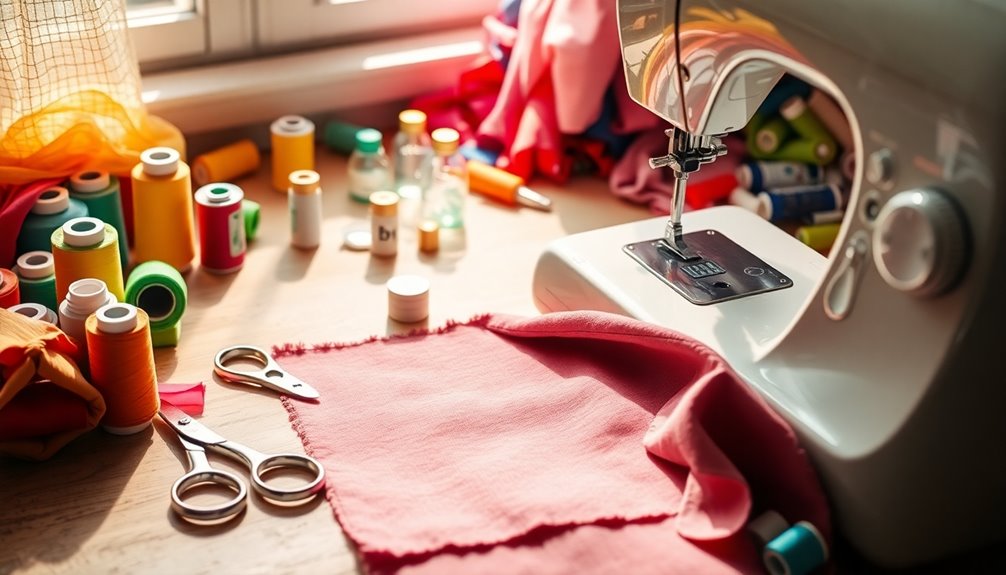
To keep your sewing tools and machines in top shape, it's essential to establish a routine care regimen. Follow these best practices to protect your tools and guarantee their longevity:
- Regular Cleaning: After each session, use a clean cloth to wipe down your sewing machine. This prevents dust and lint buildup, which can lead to wear and tear.
- Needle Maintenance: Change your sewing machine needle after every project or roughly every 8 hours of continuous use to ensure clean stitching and avoid damage.
- Proper Tool Storage: Store cutting tools like scissors in a designated container to maintain sharpness.
Also, keep small tools organized in a cool, dry spot to prevent damage and tangling. Always follow the manufacturer's guidelines for lubrication and maintenance.
Tips for Long-Term Preservation of Crafting Equipment

While you may be enthusiastic to plunge into your next crafting project, taking a moment to reflect on the long-term preservation of your tools can save you time and money in the future. Investing in high-quality materials and understanding proper care techniques will ensure your innovative crafting tools for DIY remain in optimal condition. Regular maintenance, such as cleaning and proper storage, can prevent wear and tear, allowing you to enjoy your crafting journey without interruption. By prioritizing the longevity of your tools, you’ll not only enhance your crafting experience but also protect your investment over time.
Start by regularly cleaning your tools after each use to prevent buildup. Store your tools in a dry, climate-controlled environment to avoid humidity and extreme temperatures that can cause rust.
Invest in quality storage solutions like clear plastic bins to keep your tools dust-free. Schedule routine inspections to check for signs of damage, replacing worn parts to guarantee peak performance.
Finally, use protective covers for machines and tools when they're not in use to extend their lifespan and maintain their functionality over time.
Frequently Asked Questions
How You Maintain and Take Care of Your Tools and Equipment?
To maintain and take care of your tools and equipment, clean them after each use to avoid buildup that can hinder performance.
Regularly inspect for damage or wear, ensuring everything's functioning safely.
Store your tools in a dry, organized space, using boxes or pegboards to keep them easily accessible.
For power tools, lubricate moving parts and check precision instruments.
Don't forget to change needles in your sewing machine to maintain quality stitching.
How Do You Take Care of the Sewing Tools Equipment and Materials?
You might think caring for your sewing tools is a hassle, but it's actually simple!
Start by cleaning your sewing machine after each session to keep it running smoothly.
Store scissors and rotary cutters in designated containers to prevent damage.
Change needles after every project or every 8 hours of sewing.
Finally, keep threads organized and invest in quality brands.
Regular maintenance guarantees your tools last longer and perform better!
How Have You Stored and Maintained Your Tools and Equipment at the End of the Day?
At the end of the day, you should clean your tools to remove any residue, using mild soap and water.
Store your equipment in designated containers to keep everything organized and accessible.
Make sure scissors and cutting tools are safely sheathed to prevent injuries.
Regularly check for wear and tear, replacing any damaged parts.
Finally, tidy your workspace by returning all supplies to their spots, creating a more efficient crafting environment for next time.
How to Take Good Care of the Tools and Materials Used in Embroidery?
How can you keep your embroidery tools and materials in top shape? Start by regularly cleaning your hoops, needles, and scissors to prevent lint buildup.
Store your threads in a cool, dry place to avoid fading and tangling. Change your needles after each project or every eight hours of use for better stitching.
Finally, designate a clutter-free area for your supplies, ensuring you can find everything you need quickly and easily.
Conclusion
In the world of crafting, your tools are like trusty companions on a grand adventure; they need care to keep your creative journey smooth. Just as you wouldn't neglect a loyal friend, regular maintenance guarantees your tools perform at their best. Remember the last time you pulled out a dusty paintbrush? It felt like reconnecting with an old buddy. So, invest the time in caring for your equipment, and watch your creativity flourish like a well-tended garden.
